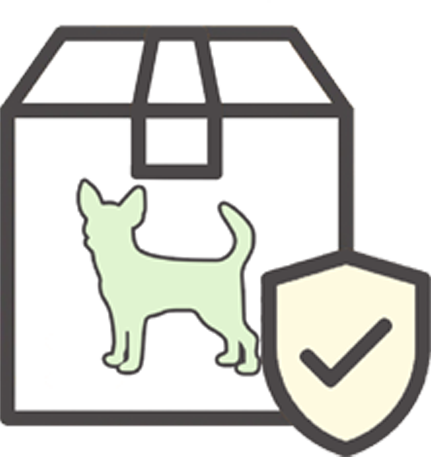Reverse Potty Training and How to Remedy It
Friday, December 20, 2019 11:59:43 AM America/Los_Angeles
Even pets that have had the most effective of house training can slide into a habit of reverse potty training, possibly due to age or recent changes in their living environment. Housebreaking a dog is just the first step. This will ensure they don’t begin to use the indoors as a pet potty due to anxiety, stress, or an underlying medical condition. Situations such as a recent move, new household member, absence of a companion, or a wide range of other factors can all trigger reverse potty training causing even the best potty trained dogs to have accidents.
How are you coping with your dog's potty-training regression in your home? Consider these possible solutions to the problem.
Training and Housebreaking
House training any pet is typically about consistency, which should begin when they are a puppy. It is far easier to instill good habits in your dog early rather than try to reverse bad behaviors, later-on. It can take months for a puppy to house train. Some may require a year or longer! Consider reverse potty training as a temporary setback and reinforce training firmly but gently. Use positive reinforcement and rewards, while taking a closer look at your pet’s environmental influences to try to identify any changes that could be affecting their behavior.
When adopting or bringing home a puppy, know that the best time to begin training your pet is when they are 3-4 months old. That does not mean that you should give up on your senior pup! Older dogs often respond well to retraining when it comes to housebreaking, so try basic commands and training tactics if reverse potty training becomes an issue. Change the natural environment by blocking off areas inside your home that your pet seems to frequently pee in and get rid of any items that they have urinated on to prevent repeat incidents. Focus on removing the smell of their urine, or they will inevitably pee in the same spot later. One way to do this is to use an enzymatic cleaner to clean up any accidents.
Pee Pads
Probably the first line of defense in dealing with reverse training is potty pads, also called pee pads, for pets. The problem with using a wee wee pad, is that they can be smelly and make it even more difficult to train your pet to associate pooing and peeing with the outdoors. Pads require daily effort and replacement which can add up to a lot of money over time, too. Worst of all, they are non-recyclable which means that they end up in landfills and hurt the environment.
Veterinary Exam
It is important to schedule a veterinary appointment for your pet that is having issues with reverse potty training in order to rule out any underlying medical issues. If you can’t pinpoint any changes that could be impacting your pet’s behavior, have a medical assessment to rule out things like bladder stones, kidney disease, diabetes, Cushing’s, or urinary tract infections.
Fake Grass
Some owners may try to curb the reverse potty problem with a potty pad made from faux or fake grass, which is used inside as an indoor potty for dogs. The typical issue with using a fake dog grass pad is that they often have an odd smell. This odor comes from the material used to diffuse odors and absorb the waste. Dogs may not be keen on this smell. Also, fake grass pads require daily maintenance to deter smells and bacteria growth. Using fake grass pads for an indoor dog bathroom could become labor intensive and tiresome over time.
Real Grass
 If your pet is looking for real grass, give them real grass! Consider one of the high-end dog grass products that are on the market, such as DoggieLawn. This is an easy way for owners to provide their pet with an indoor dog potty or pet potty, which is life-changing when a pet experiences reverse potty training. The fresh grass ensures no weird smells- and it is environmentally friendly and safe. It is clean and natural- perfect for your indoor dog potty. Don’t risk unknown toxins found in artificial potty pad solutions when a natural, mess-free option exists.
If your pet is looking for real grass, give them real grass! Consider one of the high-end dog grass products that are on the market, such as DoggieLawn. This is an easy way for owners to provide their pet with an indoor dog potty or pet potty, which is life-changing when a pet experiences reverse potty training. The fresh grass ensures no weird smells- and it is environmentally friendly and safe. It is clean and natural- perfect for your indoor dog potty. Don’t risk unknown toxins found in artificial potty pad solutions when a natural, mess-free option exists.
Make life simpler with a subscription service for your DoggieLawn fresh grass pads. Choose the frequency that best fits your life and simply wait for shipments of fresh dog potty patch grass at your door. Replace your existing pad and toss the used indoor pad in your compost bin or trash receptacle. If you are going to create an indoor potty for dogs, consider the ease of a subscription service like this.
Reverse potty training is a very-real issue with pets, particularly dogs. Address and resolve this situation with a natural solution that is not going to harm or burden the environment. DoggieLawn is a company that provides dog parents with an all-natural convenient pet potty solution. Pets using the home as a cat or dog bathroom is not uncommon; find out the underlying reason for the behavior and never punish the pet. Instead, work on training alternatives and natural solutions, like DoggieLawn for your pet.

